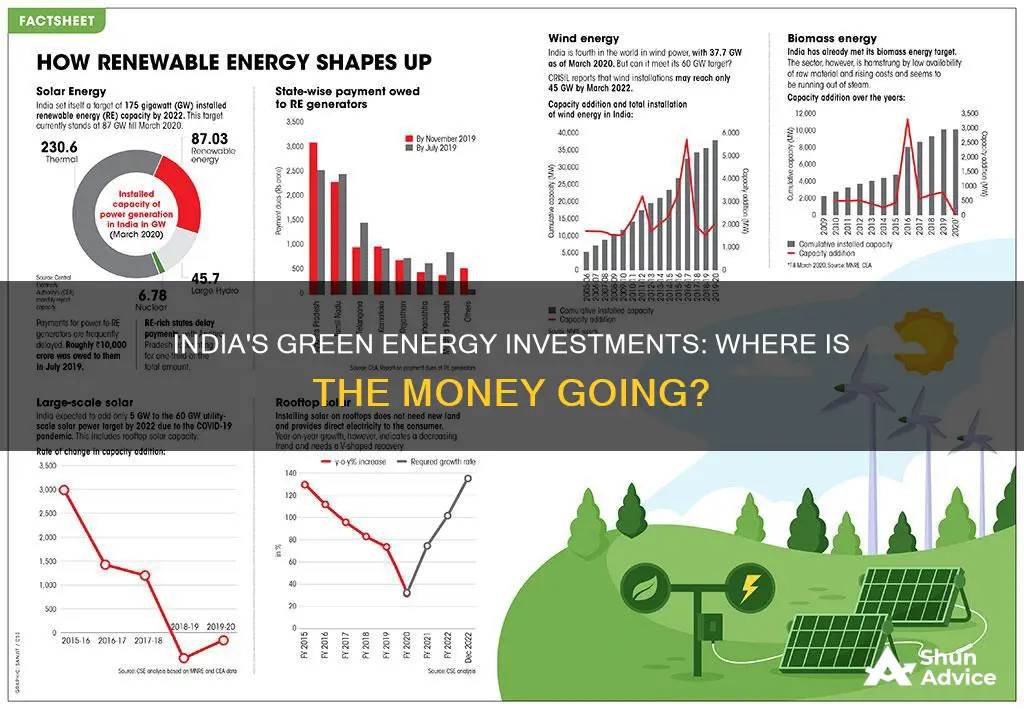
India is the world's third-largest consumer of electricity and the third-largest renewable energy producer, with 40% of its energy capacity installed in 2022 coming from renewable sources. The country has set ambitious goals to significantly increase its renewable energy capacity, with a target of 500 GW by 2030. To achieve this, the Indian government has been investing in various organizations and initiatives to promote and develop renewable energy sources such as solar, wind, and hydropower. One such initiative is the International Solar Alliance (ISA), which aims to promote solar power among its 121 member countries and has set a goal of mobilizing $1 trillion in investment by 2030. Additionally, the National Green Hydrogen Mission aims to establish a green hydrogen ecosystem and make India a global hub for green hydrogen production and export. The government has also introduced policies such as the National Wind-Solar Hybrid Policy and provided incentives like the Production Linked Incentive (PLI) Scheme to encourage the development of renewable energy projects.
What You'll Learn

Solar Energy Corporation of India (SECI)
Solar Energy Corporation of India Ltd. (SECI) is a company of the Ministry of New and Renewable Energy, Government of India. It was established on 20 September 2011 to facilitate the implementation of the National Solar Mission (NSM) and is the only Central Public Sector Undertaking (PSU) dedicated to the solar energy sector.
SECI is responsible for implementing several government schemes, including the VGF schemes for large-scale grid-connected projects under NSM, the solar park scheme, and the grid-connected solar rooftop scheme. The company also has a power-trading licence and is active in this domain through the trading of solar power from projects set up under the schemes being implemented by it.
In addition to its work in the solar energy sector, SECI has also broadened its mandate to cover the entire renewable energy domain and will be renamed the Renewable Energy Corporation of India (RECI). This change will enable SECI to become a self-sustaining and self-generating organisation with its own solar power plants that will generate and sell power. It will also allow the company to venture into other segments of solar sector activities, including manufacturing solar products and materials.
SECI plays a pivotal role in India's renewable energy sector and has faced challenges due to the instability of the country's reverse auction mechanism. However, with the launch of the National Solar Mission, SECI has the opportunity to promote the commercial introduction of CSP technology in India, which has become more affordable in recent years.
SECI has also participated in events such as the Aatmnirbhar Bharat Utsav 2024, showcasing its commitment to sustainable development and self-reliance. The company has various positions available and invites applications from interested candidates.
Invest India: Adding Value with Innovation and Expertise
You may want to see also

National Green Hydrogen Mission
India has set its sights on becoming energy independent by 2047 and achieving net zero by 2070. The National Green Hydrogen Mission, approved by the Union Cabinet on 4 January 2022, is a key part of this strategy. The mission has a total initial outlay of 19,744 crores INR ($2.3 billion) over the next 5 years, with the aim of producing 5 million metric tonnes per annum of green hydrogen by 2030. This will be supported by 125 GW of renewable energy capacity.
The objectives of the National Green Hydrogen Mission are:
- Making India a leading producer and supplier of green hydrogen globally
- Creating export opportunities for green hydrogen and its derivatives
- Reducing dependence on imported fossil fuels and feedstock
- Developing indigenous manufacturing capabilities
- Attracting investment and business opportunities for the industry
- Creating opportunities for employment and economic development
- Supporting R&D projects
The mission's projected outcomes by 2030 are:
- Developing green hydrogen production capacity of at least 5 million metric tonnes per annum, with an associated renewable energy capacity addition of about 125 GW in the country
- Over 800,000 crores INR in total investments
- Creation of over 600,000 jobs
- A cumulative reduction in fossil fuel imports of over 100,000 crores INR
- Abatement of nearly 50 million metric tonnes of annual greenhouse gas emissions
Green hydrogen is produced using electrolysis of water with electricity generated by renewable energy. It can be used for long-duration storage of renewable energy, replacement of fossil fuels in industry, clean transportation, and potentially also for decentralised power generation, aviation, and marine transport.
The challenges to producing and using green hydrogen include the availability of critical minerals such as nickel and rare earth metals, limited water resources in India, and the need for efficient transmission capacity and cross-border exchange of power between states.
A Beginner's Guide to Investing in Virtual Currency in India
You may want to see also

International Solar Alliance (ISA)
The International Solar Alliance (ISA) is a treaty-based intergovernmental alliance of more than 120 countries, most of which are "sunshine countries" that lie either completely or partially between the Tropics of Cancer and Capricorn. The alliance was first proposed by Indian Prime Minister Narendra Modi in a 2015 speech at Wembley Stadium, in which he referred tosection=section=the sunshine countries as "Suryaputra" ("Sons of the Sun"). The ISA is headquartered in Haryana, India, and was founded by Prime Minister Modi and then-French President François Hollande, who jointly laid the foundation stone of the ISA Headquarters and inaugurated the interim Secretariat at the National Institute of Solar Energy (NISE) in Gwal Pahari, Gurugram, India.
The primary objective of the ISA is to work for the efficient consumption of solar energy to reduce dependence on fossil fuels. The focus is on solar power utilization, with the alliance committing to making solar power more affordable for remote and inaccessible communities. The alliance is also known as the International Agency for Solar Policy and Application (IASPA).
The ISA has partnered with the World Bank to launch the Global Solar Atlas, a free online tool that displays the annual average solar power potential at any location in the world, helping governments and investors identify potential sites for solar power generation. The alliance has committed to investing one trillion dollars in making solar power more accessible.
The ISA has also established a $350 million solar development fund to finance solar projects. The ISA's vision and mission are to provide a dedicated platform for cooperation among solar-resource-rich countries, with the global community, including bilateral and multilateral organizations, corporates, industry, and other stakeholders, making positive contributions to assist and help achieve the common goals of increasing the use of solar energy in meeting energy needs in a safe, convenient, affordable, equitable, and sustainable manner.
The ISA has welcomed new members in recent years, including Greece, Israel, Spain, the Republic of Congo, the Solomon Islands, and the Federative Republic of Brazil.
Invest Wisely to Secure Grandkids' College Education
You may want to see also

National Solar Mission
The Jawaharlal Nehru National Solar Mission (JNNSM), or the National Solar Mission, is an initiative of the Government of India and State Governments to promote solar power in India. Inaugurated in January 2010, the JNNSM has been revised twice and now boasts an ambitious target of 100 GW of solar PV by 2022. The objective of the JNNSM is to establish India as a global leader in solar energy by creating the policy conditions for its deployment across the country.
Each phase of the JNNSM has differing key policies and targets. Phase I (2010–2013) had a target for grid-connected PV (including rooftop) of 1,000 MW and a target for off-grid solar PV applications of 200 MW. Phase II (2014–2017) increased the target for grid-connected solar PV (including rooftop) to 4,000–10,000 MW and the target for off-grid solar PV applications to 1,000 MW. This phase also included a scheme for at least 25 solar parks (34 approved under the government) and the Ultra Mega Solar Power Projects to target 40 GW of solar PV. The 13th Plan, or Phase III (2017–2022), has a cumulative target for grid-connected solar PV (including rooftop) of 100,000 MW and a target for off-grid solar PV applications (as a share of cumulative) of 2,000 MW.
To achieve its target of 50% cumulative electric power installed capacity from non-fossil fuel-based energy resources by 2030, the Government of India has launched various schemes to encourage the generation of solar power in the country. These include the Solar Park Scheme, VGF Schemes, CPSU Scheme, Defence Scheme, Canal Bank & Canal Top Scheme, Bundling Scheme, and Grid Connected Solar Rooftop Scheme.
The government has also taken several steps to promote solar energy in the country, including permitting Foreign Direct Investment (FDI) up to 100% under the automatic route, waiving Inter State Transmission System (ISTS) charges for the interstate sale of solar and wind power for projects to be commissioned by June 30, 2025, and declaring a trajectory for the Renewable Purchase Obligation (RPO) up to the year 2029-30.
As a result of these initiatives, India's solar power installed capacity has seen a significant increase, growing by 30 times in the last 9 years and reaching 90.76 GW as of September 2024. India now stands 5th in solar PV deployment across the globe, with a solar energy potential of 748 GW estimated by the National Institute of Solar Energy (NISE).
Diversifying Your Investment Portfolio: Strategies for Success
You may want to see also

National Hydrogen Mission
India's National Hydrogen Mission, announced by Prime Minister Narendra Modi in 2021, aims to make India a global hub for the production, usage, and export of green hydrogen and its derivatives. The government approved the initiative in January 2023, allocating approximately $2.4 billion for the fiscal years 2023-24 to 2029-30.
The National Hydrogen Mission is a key component of India's strategy to reduce its dependence on fossil fuels and crude oil imports, enhance energy security, and meet its climate targets. Green hydrogen, produced by splitting water into hydrogen and oxygen using electricity from renewable sources, is a significant focus of the mission.
The Indian government has waived power transmission charges for 25 years for companies producing green hydrogen and ammonia using renewable energy. These companies can also buy renewable power from exchanges or their own units and bank unconsumed renewable power for up to 30 days with power distribution companies.
The National Hydrogen Mission is expected to create a favourable environment for manufacturers of green hydrogen and ammonia, addressing concerns over the availability of renewable power and transmission. It aims to promote renewable energy generation, which will be essential for producing green hydrogen.
The initiative is also expected to bring together some of India's biggest companies, including Reliance, Tatas, Mahindras, and Indian Oil, to collaborate on clean energy options. Additionally, it is anticipated that international players with hydrogen safety technology will play a crucial role in setting up gas infrastructure and storage devices.
The National Hydrogen Mission is a significant step towards India's goal of achieving 500 GW of non-fossil energy capacity and fulfilling 50% of its energy requirements through renewable sources by 2030.
Savings: Exploring Investment Options Beyond Fixed Deposits
You may want to see also
Frequently asked questions
The Indian government has set a target of 500 GW of non-fossil fuel-based energy by 2030, with 50% of the country's energy requirements to be fulfilled by renewable sources by the same year.
The Indian government has shown strong support for the renewable energy sector through policies, programs, and financial incentives. Examples of organizations they invest in include:
- Solar Energy Corporation of India (SECI)
- Indian Renewable Energy Development Agency (IREDA)
- National Institute of Solar Energy (NISE)
- National Institute of Wind Energy (NIWE)
- National Green Hydrogen Mission
- International Solar Alliance (ISA)
The Indian government utilizes various strategies to promote renewable energy, including financial incentives such as the Production Linked Incentive (PLI) Schemes, encouraging domestic manufacturing, setting ambitious targets, and establishing policies that support the growth of the industry. They also provide capital investment, such as the US$350 million fund for solar projects and the Yes Bank loan of US$5 billion.







